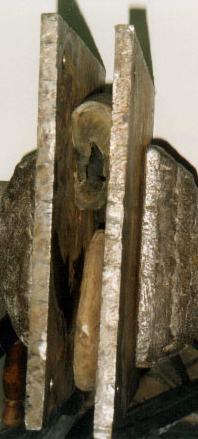


A brown trout is one of the traditional patterns for the head of a Dressed Stick ( that is a walking stick or crook with additional decoration) and it was first made for a competition at an Agricultural Show in Northumberland. The stick I am making is for presentation purposes and as such there is a later addition that would not normally be on a stick such as this.
The Horn has to be seasoned in much the same
way as wood; normally between one and two years after the horn
has been removed will be a sufficient length of time.
 This is the is the horn after
it has been removed from the Ram's head, it still contains the
core, which is the growing part of the horn and which is similar
to the nail bed on a human.
This is the is the horn after
it has been removed from the Ram's head, it still contains the
core, which is the growing part of the horn and which is similar
to the nail bed on a human.
The red mark on the horn is where I estimate the core will end so that the horn is hollow to this point.
The core has to be removed and I do this by knocking the end of the horn on a concrete floor.
 This is the core removed and
at this stage the hollow can be measured. In both photographs
one can see the spiral in the horn; this has to be removed.
This is the core removed and
at this stage the hollow can be measured. In both photographs
one can see the spiral in the horn; this has to be removed.
To achieve this the horn must be boiled for at least an hour, but longer if it is particularly dense. If you are doing this in the kitchen wait until your wife is out and have the extractor fan turned to full!!
Whilst the horn is boiling assemble the tools for flattening the horn, I use a single leg vice, sometimes known as a blacksmith's vice and two strong metal plates. Some stickdressers use a press fashioned from a bottle car jack and a metal frame with two plates, but this must be strong enough to cope with the pressure
 |
 |
|
This shows the horn, from the side clamped between the two metal plates. It should be squeezed to about one and one-quarter inches so there is horn to be removed to reach the required size. |
This is looking down on the horn and it can be seen how the core hole has become elongated. Each horn has a concave side, the head side of the horn, and a convex side, the outside of the horn and this squeezing will with luck balance them up. |